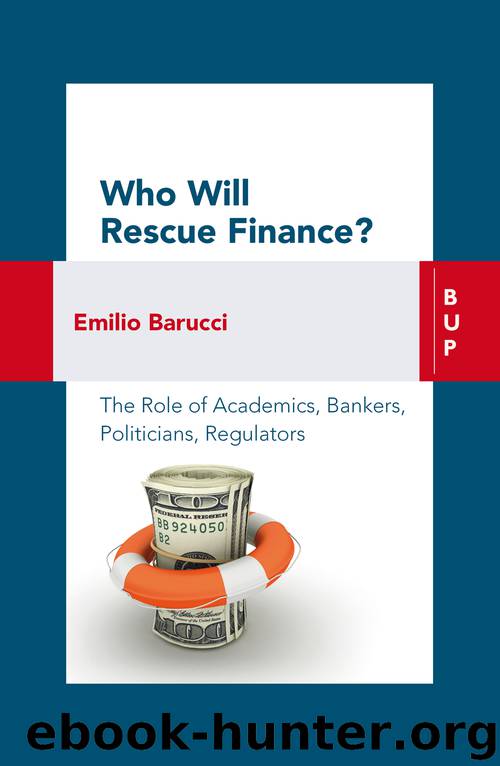Who will Rescue Finance? by Barucci Emilio

Author:Barucci, Emilio
Language: eng
Format: epub
Publisher: EGEA Spa - Bocconi University Press
1. Volume, risk, and profits
The possibility of expanding banks’ activities and eliminating the constraints on the aggregation processes and the instruments that could be exchanged on financial markets, have brought about two phenomena that were not necessarily intended by regulators and policy makers.
First, we have witnessed very significant growth in the role of banks compared to the real economy. If we take the ratio of banks’ assets to GDP as a reference, we see that it has accelerated significantly since the 1990s. On average, at the level of the European Union, the bank assets were 200% of GDP in 1999, and grew to more than 300% at the time of the outbreak of the financial crisis, with a slight decrease thereafter. The financial markets in a strict sense (stock and bond markets) did not experience equally significant growth: the market capitalization/GDP ratio increased from 190% to 230% on average at the European Union level. This trend was confirmed internationally.3 The result of this evolution is that the relationship between banks’ assets and financial market capitalization--an indicator of the centrality of banks in the financial system--went from 100% in 1999 to 160% in 2007, and then to 120% in 2015. The weight of banks compared to financial markets has therefore been growing since the early 2000s.
At the European level there is weak evidence that there was a convergence towards a market-based economy before the crisis. The evolution of European financial systems in the new millennium can be more properly described as a credit-driven bubble that collapsed with the crisis, yielding a de-leveraging process in the economy. Before the crisis, we observed a significant increase of leverage in non-financial companies and households, with some evidence of convergence among European countries. The crisis reversed these trends, and yielded a cross-country convergence towards a reduction of the assets of monetary and financial institutions and an increase of the role of other financial intermediaries (including shadow banking).4
We can conclude that the process of deregulation in finance has not led so much to an expansion of financial markets, as to increasing the role of banks.
Secondly, we see growth in the concentration of the banking system. On average, in the European Union, the share of the assets of the top five banks in each country rose from 35% to more than 45%. The phenomenon is not only European; thirty-seven American banks merged between 1990 and 2010 to form four giants (JPMorgan Chase, Citi, Bank of America, and Wells Fargo), which now account for 45% of deposits in the United States. The financial crisis seems to have accelerated the concentration process rather than interrupting it.
Concentration is high in the commercial banking industry, and also in what is considered to be the temple of finance: the world of the investment banks. Analysing the investment bank market in the post-crisis period, we observe that the top five banks steadily generate 30% of total bank revenues. What is striking is the stability of this financial aristocracy, which is comprised exclusively of U.
Download
This site does not store any files on its server. We only index and link to content provided by other sites. Please contact the content providers to delete copyright contents if any and email us, we'll remove relevant links or contents immediately.
The Black Swan by Nassim Nicholas Taleb(6763)
Bad Blood by John Carreyrou(6274)
Pioneering Portfolio Management by David F. Swensen(6078)
Millionaire: The Philanderer, Gambler, and Duelist Who Invented Modern Finance by Janet Gleeson(4093)
Skin in the Game by Nassim Nicholas Taleb(3965)
The Money Culture by Michael Lewis(3846)
Bullshit Jobs by David Graeber(3828)
Skin in the Game: Hidden Asymmetries in Daily Life by Nassim Nicholas Taleb(3722)
The Wisdom of Finance by Mihir Desai(3523)
Blockchain Basics by Daniel Drescher(3329)
Liar's Poker by Michael Lewis(3220)
The Intelligent Investor by Benjamin Graham Jason Zweig(2930)
Hands-On Machine Learning for Algorithmic Trading by Stefan Jansen(2925)
Mastering Bitcoin: Programming the Open Blockchain by Andreas M. Antonopoulos(2891)
Fooled by Randomness: The Hidden Role of Chance in Life and in the Markets by Nassim Nicholas Taleb(2860)
Investing For Dummies by Eric Tyson(2793)
The Power of Broke by Daymond John(2772)
Market Wizards by Jack D. Schwager(2538)
Zero Hour by Harry S. Dent Jr. & Andrew Pancholi(2531)
